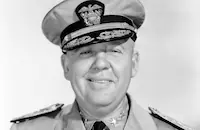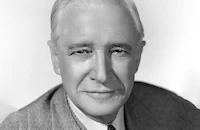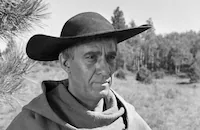The Bribe

Brief Synopsis
Cast & Crew
Robert Z. Leonard
Robert Taylor
Ava Gardner
Charles Laughton
Vincent Price
John Hodiak
Film Details
Technical Specs

Synopsis
Rigby, a government agent investigating an arms surplus racket on the Central American fishing island of Los Trancos, falls in love with one of his suspects, café singer Elizabeth Hintten. While considering his affair with Elizabeth, Rigby recalls the day in Washington, D.C., when his boss, Gibbs, first briefed him on the case: Gibbs tells Rigby that a group of racketeers have been diverting war surplus items and airplane motors to Central America, where they are refitted and sold for profit. Assigned to locate the motors and raid the racketeers' headquarters, Rigby is told that the government suspects Elizabeth and her alcoholic war veteran husband Tug. After arriving in the Los Trancos town of Carlota, Rigby, posing as a sportsman, finds Elizabeth singing at Pedro's nightclub and befriends her. Rigby and Elizabeth soon strike up a romance, though Tug is either too drunk or too busy to notice. One night, at a bar, Rigby is approached by J. J. Bealer, a waterfront thief, who, after telling Rigby that he knows about his investigation, offers him $10,000 to leave the island. Rigby rejects the bribe, and soon comes to suspect that a man named Carwood, who is posing as a mine owner, is somehow associated with Bealer. The following day, in order to learn more about Carwood, Rigby joins him on a fishing trip. The fishing expedition nearly proves fatal for Rigby when Carwood deliberately causes the fishing boat to lurch forward while Rigby is standing near the edge. Rigby is falls into the water, but Emilio Gomez, the boatman, jumps into the water and saves him. Emilio, however, is killed by a shark while trying to swim back to the boat. A short time later, Emilio's father Pablo confirms Rigby's suspicions that Carwood is the mastermind of the smuggling operation, and, angered by his son's death, volunteers to help Rigby investigate the men responsible. As Rigby comes out of his reverie, he is still torn between his love for Elizabeth and his obligation to investigate her. His decision is to save Elizabeth from prosecution by accepting Bealer's bribe and fleeing from the island with her. However, before Rigby can tell Elizabeth his plan, Bealer convinces Elizabeth that her husband is a criminal and that Rigby is an investigator who intends to put him in prison. In the hope of saving Carwood's illicit operation, Tug enlists Elizabeth's help in drugging Rigby long enough to allow all those involved in the smuggling ring to flee. Rigby loses consciousness soon after drinking a cocktail tainted with a heavy sedative, but Elizabeth immediately feels remorse for what she has done. Carwood, meanwhile, murders Tug for talking too much, and makes preparations to flee. Rigby regains consciousness sooner than Carwood had anticipated, and sets out in search of his suspects. When Rigby tries to arrest Carwood, Carwood shoots Bealer and escapes into a crowded carnival. After killing Carwood, Rigby resumes his romance with Elizabeth, whom he now knows to be innocent.

Director

Robert Z. Leonard
Cast

Robert Taylor

Ava Gardner

Charles Laughton

Vincent Price

John Hodiak

Samuel S. Hinds

John Hoyt
Tito Renaldo

Martin Garralaga
Pepe Hernandez
Robert Cabal
Richard Lopez
David Cota
Nacho Galindo
Walter Anthony Merrill
Frank Mayo
Marcel De La Brosse
Albert Pollet
Juan Duval
Joe Dominguez
Albert Morin
Ernesto Morelli
Julian Rivero
William Haade
Felipe Turich
Alfonso Pedroza
Charles Gonzales
Fernando Alvarado
Peter Cusanelli
Jerry Pina
Harry Vejar
Phyllis Graffeo
Florita Romero
Roque Ybarra
George Navarro
Paul Regas
Bob Lugo
Alex Montoya
Tony Roux
Harry Johnson
Duke Johnson
Pedro Regas
Don Zelaya
Crew
Pandro S. Berman
Malcolm Brown
Nacio Herb Brown
Jack Dawn
Cedric Gibbons
A. Arnold Gillespie
Bert Glazer
Sydney Guilaroff
Hugh Hunt
Irene
William Katz
Robert Z. Leonard
Warren Newcombe
Marguerite Roberts
Miklos Rozsa
Gene Ruggiero
Joseph Ruttenberg
Douglas Shearer
Edwin B. Willis
Eileen Wilson
Eddie Woehler

Photo Collections
Videos
Movie Clip




Trailer
Film Details
Technical Specs

Articles
The Bribe
Dockside rat J. J. Bealer (Charles Laughton) offers Rigby a hefty bribe to walk away. Is the gorgeous club singer Elizabeth Hintten (Ava Gardner) really interested in Rigby, or is she part of the conspiracy too? The big local industrialist Carwood (Vincent Price) may or may not have tried to dump Rigby into shark-infested waters during a fishing trip. Rigby seems set to betray his mission and run off with Elizabeth, but her alcoholic husband Tug (John Hodiak) makes the first move, drugging the agent so the conspirators can make their escape. Robert Taylor pouts his way through a tough-guy narration and an explanatory flashback, but we never doubt that Rigby will do the right thing. Meanwhile, various minor players are eaten by sharks, etc.
Cinematographer Joseph Ruttenberg lays on the mysterioso lighting and Miklós Rósza's dynamic music must work hard to generate tension. The Hollywood Reporter was not impressed by Vincent Price and Charles Laughton's outsized performances. Behaving like Charles Dickens' Uriah Heep and complaining about his sore feet, Laughton's Bealer is too sleazy to bribe anyone. Not yet established as a film villain, Price nevertheless lays on the insincere manners and arch allusions as Carwood. Going against the noir grain, Ava Gardner is revealed to be a concerned wife, not a femme fatale. Newsweek thought the film looked overblown, especially the spectacular nighttime finish in which the un-touristy town of Los Trancos puts on a fireworks show as impressive as a Manhattan Fourth of July.
Film critics revisiting the blacklist years have rediscovered The Bribe's screenwriter Marguerite Roberts. Her burgeoning career was cut short in 1951 by HUAC, with her credit removed from MGM's superlative Robert Taylor movie Ivanhoe (1952). Seventeen years later, Roberts' fine screenplay for True Grit (1969) gave John Wayne his only Oscar win.
By Glenn Erickson

The Bribe
The Bribe
The Bribe was the first of three films at MGM which teamed Robert Taylor and Ava Gardner (The other two were Ride, Vaquero! and Knights of the Round Table, both 1953). It was an arrangement that pleased Ms. Gardner enormously, as recounted in her biography, Ava: My Story: "Set on some fictitious island off the coast of Central America, which looked suspiciously like Mexico on MGM's all-purpose backlot, The Bribe had me tangentially connected to a nasty plot to smuggle surplus American aircraft engines into South America. I was excused from my usual slinky black dress and put into Mexican huaraches and fetching native blouses to match the climate. And though I seemed to be happy singing and dancing at the local cantina, my main job was to take one quick look at Mr. Taylor....and fall into his arms. This time, it not only happened on screen, it happened for real. There's no rhyme or reason about a love affair. In those days, I was in constant proximity to some of the most handsome, romantic figures on earth, and they didn't move me the slightest bit. Not that I didn't adore men. I did....But I was a one-man woman. I did not want a string of lovers. I had to like a man one hell of a lot to let him disturb my sleep. But since Howard Duff and I had split by that time, I was available. And Bob Taylor surely fit the bill for me, and I did the same for Bob...Our love affair lasted three, maybe four months. A magical little interlude."
While Gardner didn't win any prizes for her performance as the deceptive Elizabeth Hintten in The Bribe, almost everyone agreed she looked ravishing, despite her heavy partying off-camera. On the other hand, Robert Taylor, long stereotyped by MGM as their reigning matinee idol, was finally developing into a first rate actor who would go on to give his best performances in film noirs like Rogue Cop (1954) and Party Girl (1958). The Bribe was an important step in this direction, establishing Taylor as a hard-boiled, cynical hero but he wasn't at all fond of the film. He confessed to Gardner that he thought it "was one of the worst movies he'd ever made."
Ironically, the tough dialogue and sleazy underworld characters of The Bribe - usually the province of macho mystery writers like Dashiell Hammett - were created by Marguerite Roberts, who usually wrote screenplays specifically for MGM's major male talent like Clark Gable. Unfortunately, Roberts was very much the bohemian radical and her politics got her into serious trouble in the fifties. She was hauled before the House Un-American Activities Committee in September 1951 and refused to cooperate. Consequently MGM terminated her contract and her name was removed from the screen credits of Ivanhoe, her final film for the studio
Producer: Pandro S. Berman
Director: Robert Z. Leonard
Screenplay: Frederick Nebel (story), Marguerite Roberts
Art Direction: Malcolm Brown, Cedric Gibbons
Cinematography: Joseph Ruttenberg
Costume Design: Irene
Film Editing: Gene Ruggiero
Original Music: Nacio Herb Brown (song), William Katz, Miklós Rózsa
Principal Cast: Robert Taylor (Rigby), Ava Gardner (Elizabeth Hintten), Charles Laughton (J.J. Bealer), Vincent Price (Carwood), John Hodiak (Tug Hintten), Tito Renaldo (Emilio Gomez).
BW-98m. Closed Captioning.
by Jeff Stafford
The Bribe
Quotes
Look, why don't you stop acting like you're alone in the jungle?- Rigby
I'm not?- Elizabeth
OK, so you are, but you'd be surprised how nice the birds and the beasts can be if you'll only give them a chance.- Rigby
Tell me, Rigby, do you fly, walk on all fours...or crawl?- Elizabeth
I never knew a crooked road could look so straight.- Rigby
Trivia
Notes
An April 1947 Hollywood Reporter news item announced that M-G-M paid $10,000 for the screen rights to Frederick Nebel's short story. An early October 1948 Hollywood Reporter news item noted that because of a preview audience's reaction to the film, M-G-M ordered threre days of reshooting to bolster the love scenes between Ava Gardner and Robert Taylor.















